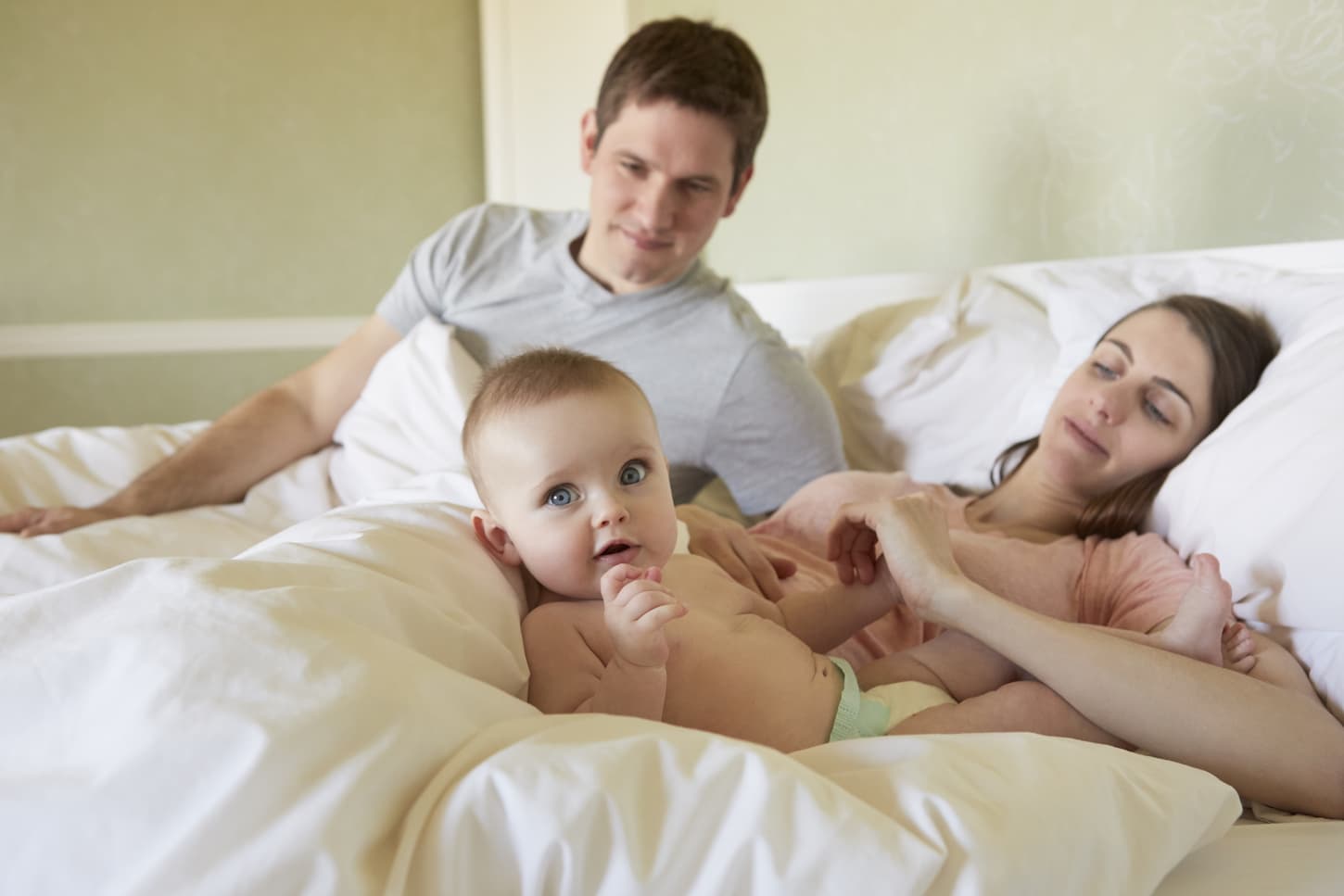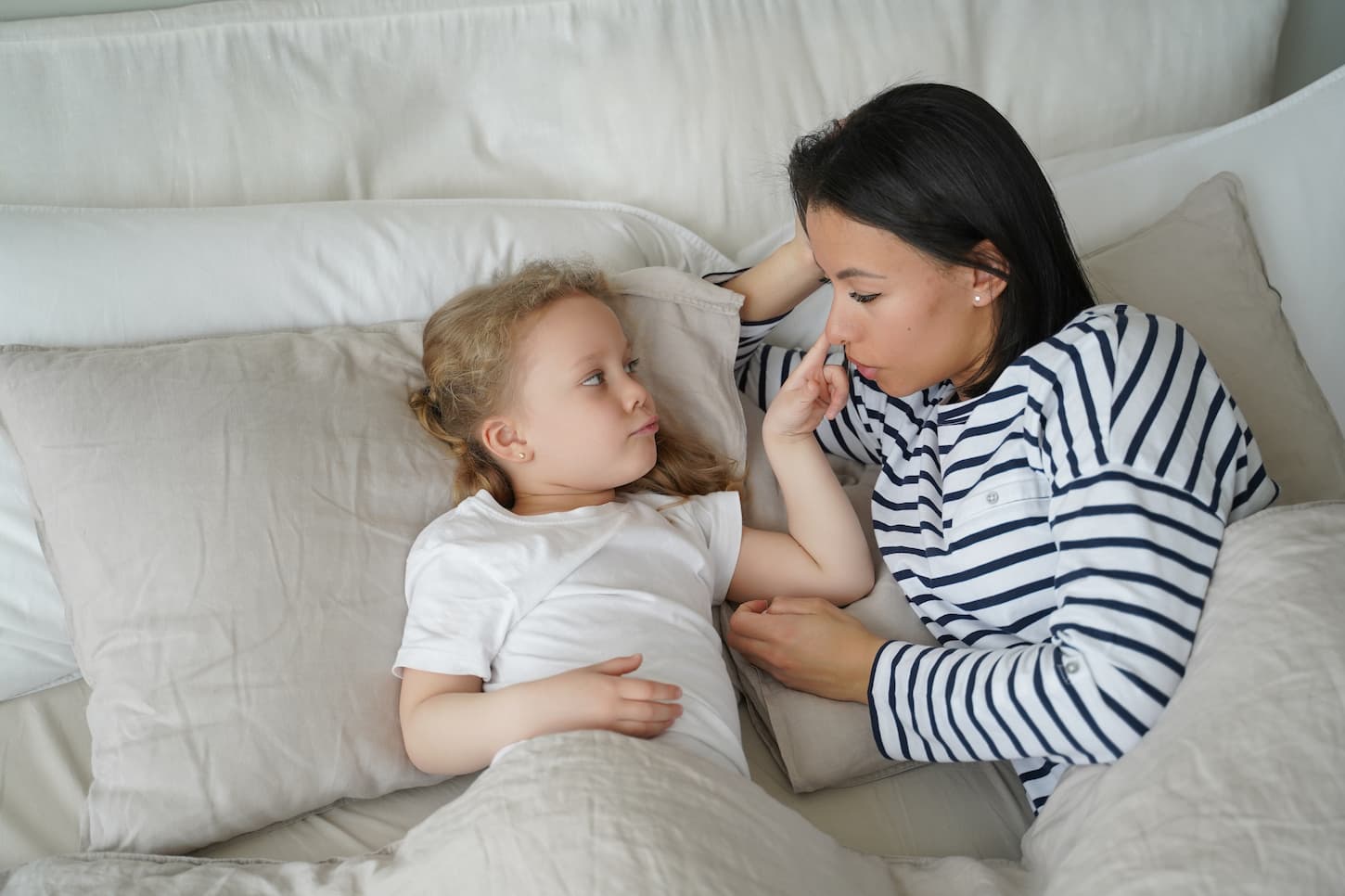When I was sleep-deprived and researching sleep training like crazy, I wished like crazy there was some kind of sleep training guidelines I could reference. So let’s talk about common sleep training guidelines should parents know about.
Sleep training guidelines:
- Know when it’s appropriate and safe to sleep train.
- Choose a sleep training method that fits with your parenting style and goals.
- Use that sleep training method to create your own custom sleep training plan.
- Know that you may have to change the plan as needed.
- Remember that sleep training success requires dedication, consistency, and time – sometimes as long as a month or more.
In order to help you through these guidelines, gain the confidence you need to sleep train successfully, and answer commonly-asked sleep training questions, keep reading!

Sleep Training Guidelines: The Basics
In order to help you through the sleep training guidelines, I’ve created a list of tips and answers to commonly-asked questions. There are 10+ things in here that you’ll want to know the answers to. I know that because they’re the exact things I wondered as I extensively researched and implemented sleep training in my family.
Sleep Training Isn’t Always Necessary
The first thing to know is that sleep training isn’t right for everyone. In fact, the peer-reviewed studies I’ve read have said that sleep training is really only required for children with frequent night wakings or sleep issues. These studies report that:
Bedtime problems and frequent night wakings are highly prevalent in young children, occurring in approximately 20-30% of infants, toddlers, and preschoolers.
American Academy of Sleep Medicine
In other words, your child may not require sleep training. However, if you found this article, odds are you may need it. Otherwise, why are you searching for information on sleep training guidelines, right?
In any case, to read my full article on whether or not sleep training is necessary, make sure you click right here.
Science Says Sleep Training Is Safe
Next, it’s important to know that sleep training, when done right, is completely safe. In fact, the American Academy of Pediatrics says:
Behavioral sleep techniques have no marked long-lasting effects (positive or negative.) Parents and health professionals can confidently use these techniques to reduce the short- to medium-term burden of infant sleep problems and maternal depression.
American Academy of Pediatrics, October 2012 Volume 130 Issue 4
In other words, sleep training makes things better now – and doesn’t have any lasting impact on our kids. That’s a true win-win.
Read: my article, Sleep Training: Safe and Okay OR Cruel and Traumatizing?
So what are behavioral sleep training techniques? Are they different from regular sleep training techniques?
Behavioral sleep training methods focus on parent education and gradual sleep changes while meeting a child’s physical, emotional, and psychological needs. If you’d like more details, make sure you read my complete guide to behavioral sleep training.
Many of the popular and common sleep training methods are behavioral-based.
On the other hand, pure extinction (cry it out) is NOT a behavior-based sleep training method.
Sleep Training Is Teaching Kids to Love and Enjoy Sleep
What is sleep training? On a technical level, sleep training is teaching children how to self-soothe so that they sleep better. Sometimes, sleep training is done to help children learn to adjust to family or society-determined schedules.
But at its core, sleep training is much simpler: it’s teaching children to learn to love and enjoy their time spent sleeping. Because if we can help children learn how amazing sleep (and naps!) is, then they’re going to want to get enough sleep.
Oh, and as a cool bonus? Rested children learn and grow better and are generally healthier than their sleep-deprived counterparts.
So really, sleep training is helping children learn to enjoy sleep – all while helping them build the foundation for a healthier, happier life.
When Can I Start Sleep Training?
Generally speaking, you can start sleep training any time that there is a significant sleep disruption in your home.
If children aren’t getting enough sleep and it’s a problem (however you define that), you can use behavioral sleep training.
There is one major exception to that rule of thumb, though.
Sleep Training Newborns Is Physically Impossible
Newborns experience a tremendous amount of growth during their first four months – or the “fourth trimester.” During these four months, they’ll sleep when and where they want. There’s not much you can do to change it.
Believe me – I tried with all four of our children. And I failed all four times.
Until a baby’s brain has physically developed enough, a baby is incapable of sleeping long or well enough to formally sleep train. This development is usually completed by 4 months of age, although it can take longer.
Now, that being said, some people are able to practice good sleep training habits with their newborns – and see varying levels of success. It’s just going to depend on several factors – the main one being your child’s personality.
So it may be worth practicing sleep training. In a worst-case scenario (like what happened to us), your newborn won’t have adjusted but you will have learned a lot about sleep training.
Even so, make sure you read my article on the best sleep training options for babies under 6 months of age.
Start Focused Sleep Training As Needed (After 4-6 Months Old)
Once your baby is at least 4 months old, you can begin using focused behavioral sleep training – and you’ll even be able to see actual results.
We waited until closer to 7-8 months to sleep train, but that was a personal choice.
That being said, let’s remember our earlier rule: you really only need to sleep train if there’s a sleep problem that needs addressing.
Example: if you cosleep with your 8-month-old, who still wakes 1-3 times each night to nurse, but it’s not a problem? You don’t have to sleep train.
Just to make things easier, here’s a fancy chart so you know exactly how old your baby should be when you start sleep training.
How Old Should Baby Be When You Start Sleep Training?
| Age | Sleep Training Stage | What You Need to Know |
|---|---|---|
| Newborn (0-6 weeks) | Pre-Sleep Training: Sleep Survival Mode | Routines and schedules are nice goals to have; focus on getting enough sleep to survive. |
| 2-3 months old | Pre-Sleep Training: Sleep Learners | The baby can start learning or “practicing” for sleep training. It may or may not take another few months. Even so, practice those bedtime routines! |
| 4-6 months old | Sleep Training is a go! | Now that your baby’s brain has matured and sleep patterns will become more adult-like, formal sleep training can begin if needed! |
| 6 months and older | Sleep Training is a go! | Your baby’s ready for some solid, restful sleep. If they can’t achieve that on their own, use sleep training to guide them to a full night’s sleep. |
Now let’s get you more prepared for sleep training.

Be Prepared for Sleep Training
Before you sleep train, you need to ask yourself these 5 questions:
- Do you have several weeks’ worth of uninterrupted time to dedicate to sleep training?
- Are you confident in the sleep training method you’ve chosen and how to implement it?
- How ready are you to commit to the process and follow your outlined plan?
- Is your team (spouse, partner, family) on board with the plan? How will they help?
- Can you sleep train, making changes as needed, for at least 2-4 weeks?
You need to be able to confidently answer each question before you sleep train. If you aren’t able to confidently answer them, these should help you know where you to focus your efforts.
Example: If you have a work trip or a family vacation scheduled in 10 days, now is not the time to start sleep training. Go ahead and wait until you get back.
Sleep Training and Crying: Tips To Know
Next, let’s talk about sleep training and crying.
Some methods of behavioral sleep training do call for allowing your baby to fuss (or even cry) for a few minutes before you step in to help comfort them. When you let your baby cry for a short amount of time and then respond to them, that’s an intentional, planned step to help them learn self-soothing techniques. That’s not cruel.
In fact, studies have shown that:
Behavioral sleep techniques have no marked long-lasting effects (positive or negative.) Parents and health professionals can confidently use these techniques to reduce the short- to medium-term burden of infant sleep problems and maternal depression.
American Academy of Pediatrics, October 2012 Volume 130 Issue 4
So if you do choose a sleep training method that allows a few minutes of crying, don’t feel bad. It’s not cruel.
Next, let’s talk about when letting a baby cry is cruel. Because sometimes an extreme example is the best way to prove a point.
Letting Babies Cry: When It’s Cruel
Letting your baby cry without responding to them is damaging – both physically, psychologically, and emotionally.
Crying is a baby’s way of asking for help, like if they have a poopy diaper. If a baby’s cries go unanswered, their bodies release cortisol, a stress hormone. So not only are they still sitting in a poopy diaper but now they’re also stressed out. And if that diaper isn’t changed soon? They’re going to have a diaper rash to boot.
Emotionally and psychologically speaking, if a baby’s cries for help go unanswered long enough there are significant problems. The most disconcerting of which is that babies stop crying period.
When describing a room full of infants who had learned they would not be responded to, Dr. Nathan Fox said:
The most remarkable thing about the infant room was how quiet it was, probably because the infants had learned that their cries were not responded to.
Dr. Nathan Fox, PhD as reported by the American Psychological Association
Now, these babies weren’t responded to at all except to have their basic physical needs met – and even that was on a schedule. So this learned reaction took place over many days, weeks, or even months.
This probably won’t happen to your baby if you’re only allowing them to cry for just a few minutes. Especially not if you’re headed right back into their room to comfort and check on their needs.
So letting a baby cry without being checked on is cruel and can cause lasting damage. Letting them cry for a few minutes, though? Remember: studies showed no lasting permanent effects of any kind.
Sleep Training: Tears Not Required
Now, just because a few minutes of crying isn’t cruel (or leaves any lasting effects), it’s still heartbreaking to hear. And, for many parents, that makes any sleep training method that involves crying a no-go.
Guess what? You can still teach your baby to sleep – without them having to cry.
So if you don’t want to let your baby cry while sleep training, know that you aren’t alone. Several of the behavioral sleep training methods are explicitly designed to be tear-free experiences for both parents and babies.
You don’t have to let your child cry in order to successfully sleep train them.
How Long Do You Let a Baby Cry It Out?
So, how long should you let your baby cry it out? You can let your child cry for a few minutes or an hour, as long as they’re in a safe, controlled environment; their needs are all met; they will receive comfort if needed; the parents agree that stepping in isn’t the right decision to make at this time.
Many of the behavioral sleep training programs call for gradually increasing amounts of time between checking on your children. However, your baby may (or may not) be crying during this entire time.
In other words, there’s no set time that’s recommended for letting your child cry. However, after surveying 800+ parents, most think that an hour is plenty of time to let your child cry.
After an hour or if your child needs help, please step in.
For example, if your child becomes so agitated that they begin to vomit, it’s time to go comfort them and clean them up – no matter how long they’ve been crying.
All The Options: Sleep Training Methods
Ready to choose your preferred sleep training method? Let’s take a quick look at the most popular ones.
| Behavioral Sleep Training Method | Definition of Methodology | Well Known Example |
|---|---|---|
| Graduated Extinction | Parents gradually delay their response to an infant’s cry. | Ferber Method |
| Controlled Comforting | Parents physically comfort a crying child, though the length and type of comfort gradually diminish. | Healthy Sleep Habits, Happy Child |
| Bedtime Fading | A parent gradually delays an infant’s bedtime over time. | |
| Adult Fading | A parent gradually stays less and less time with a child after putting them down for bed. A parent may comfort as desired. | Pick Up, Put Down |
| Camping Out | A parent “camps out” in the room after bedtime. Each night, the parent moves their chair one step further from the crib until the child graduates from needing a parent present to fall asleep. | The Chair Method |
Really – there’s no wrong answer. Pick the one that appeals most to you. You can always tweak a specific method to make it your own. That way, you can confidently and successfully sleep train your child.
Getting Help: Sleep Books, Sleep Consultants, and Sleep Products
As you’re researching the various sleep training methods, getting help is a valid option.
You can get that help via a book, a sleep consultant, a sleep training program, and countless sleep products that make sleep training easier.
There are so many to choose from – and it’s nice to have options!
Just like when you’re choosing a sleep training method, choose the help that appeals to you – and fits your budget. Because it is possible to get help on any budget.
Example: If you’d like to use a sleep training book, don’t forget to see if your local library has it first. Or, see if there’s an eBook version – they’re usually cheaper than a hard copy.
If you’d like to see what I use, please check out my recommended resources.
Important Reminder: Success Takes Time
When friends told me about how they were able to sleep train overnight, I remember how jealous I was. Because even when we tried letting our kids cry for an hour (or more) before going in to check on them, it never resulted in an overnight success.
So remember: your success will look different than anyone else’s. And it will probably take more than one night – more like 2-4 weeks.
Your exact path to success (and how long it takes) will depend on the method you choose, your consistency, a ton of other factors, and your baby’s personality.
Tip: Keep a journal of your baby’s progress. That way, you can see things getting better without relying on a sleep-deprived memory.
When To Skip (or Quit) Sleep Training
Is there ever a time when you should quit, skip, or put a hold on sleep training? Absolutely. If sleep training is becoming problematic, too stressful, or it’s just not working (despite a consistent effort), it’s time to at least reevaluate.
For more details on when and why you should quit sleep training, read my article on it right here.

Sleep Training Guidelines Made Easy
Now that you’ve read this whole article, let’s look at those sleep training guidelines again. You should be able to answer them much more confidently.
- Know when it’s appropriate and safe to sleep train.
- Choose a sleep training method that fits with your parenting style and goals.
- Use that sleep training method to create your own custom sleep training plan.
- Know that you may have to change the plan as needed.
- Remember that sleep training success requires dedication, consistency, and time – sometimes as long as a month or more.
Sleep training isn’t some scary, difficult thing. It’s a process that helps everyone sleep better – without the stress. You’ve got this.
Related Questions
How Do You Do the Ferber Sleep Method? The Ferber sleep training method: 1. Use a bedtime routine. 2. Put the baby to bed. 3. When the baby cries, check on them in regular but increasing intervals so they learn to self-soothe.
Do I Have To Use A Sleep Training Method for My Child? No, you don’t. Many families are able to sleep train without a formal program simply by using techniques learned from friends, families, or information online.
How Do I Pick the Right Sleep Training Method For Me and My Baby? After researching sleep training, select the sleep training method that matches best with your parenting style and goals. Then try it out and change methodology as needed.